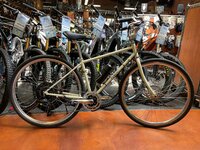PedalUma
Well-Known Member
- Region
- USA
- City
- Petaluma, CA
I agree that most electric bikes in the States are recreational toys facing price pressure. Hence the high weight and crappy components on most. Like a Tourney on an Ultra. People are buying based on output specs and low price. Not on quality. Here is a chain below that I like. This one lasts like a belt at a fraction of the cost. Take this one-speed chain like the Dutch from a mid-drive to an internal hub of gears. Hopefully Holland is the future for us. Bikes for daily transportation everywhere. Here is one innovation I came up with this week. A bike that can easily switched from Class 3 to Class 1 to go into restricted areas. All it takes in getting off the bike and moving the chain to the smaller climbing ring. I also agree that batteries will get smaller. You can see the discharge wire in the first photo.






